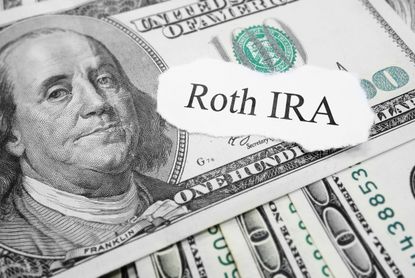How to Open a Roth IRA in Five Simple Steps
Here's what you need to know in order to easily open a Roth IRA.


Are you looking to open a Roth IRA to let your money grow tax-free? Roth IRAs are individual retirement accounts that let you save for retirement with after-tax dollars. Since taxes are paid on contributions before they’re placed in the account, withdrawals from a Roth IRA can be made tax-free at a later date — making them good savings options for individuals who expect to be in a higher tax bracket in the future.
And since the IRS has increased contribution limits on Roth IRAs for 2024 and 2025, you can save even more than in previous years. In 2023, the maximum amount you could contribute to a Roth IRA was $6,500, with an extra $1,000 per year in "catch-up" contributions for adults ages 50 and over. In 2024 and 2025, however, you can contribute up to $7,000, as well as an extra $1,000 in catch-up contributions.
Sound appealing? Here’s how to open a Roth IRA in five simple steps.

Sign up for Kiplinger’s Free E-Newsletters
Profit and prosper with the best of expert advice on investing, taxes, retirement, personal finance and more - straight to your e-mail.
Profit and prosper with the best of expert advice - straight to your e-mail.
1. Make sure you're eligible to open a Roth IRA
The first step in opening a Roth IRA is determining if you’re eligible. In order to be eligible for a Roth IRA, you’ll need to have earned income, and this income must be within certain limits.
In 2024, in order to contribute the maximum amount to your Roth IRA ($7,000 or $8,000 if you are 50 or older), your income must be no more than $146,000 for single filers or $230,000 for those married filing jointly. For 2025, the income cutoff levels rise to $150,000 and $236,000, respectively.
If your income exceeds this, your contribution limit will begin to phase out until it disappears. In 2024, the phase-out range for single filers is between $146,000 and $161,000 (rising to a range of $150,000 to $165,000 in 2025), and $230,000 and $240,000 for those married filing jointly (rising to a range of $236,000 to $246,000 in 2025).
If you make more than this, you could potentially benefit from using a backdoor Roth IRA, where you convert a traditional IRA to a Roth. Or consider qualifying for Roth IRA contributions by lowering your income.
2. Choose a provider
Now you’ll need to choose where to open an account. Roth IRA accounts can be opened through a number of places, including mutual fund firms, full-service brokerages and financial planning firms. You can open a Roth IRA account at almost all investment companies. If you’re planning on picking your own investments, opening a Roth IRA at an online broker is a good choice. On the other hand, if you’re more of a hands-off investor, consider a robo-advisor.
When searching for Roth IRA providers, it's important to compare minimum investment requirements and maintenance fees, if any. Also consider whether or not the company offers the types of investments you’re looking for (mutual funds, ETFs, etc.), how much it costs to trade and if the account offers any additional tools like a retirement calculator.
3. Fill out the paperwork
After choosing a provider, it's time to apply. In many cases, you can complete a Roth IRA application online, but you'll need to gather some paperwork in order to do so. Here's what you'll need to have on hand during the sign-up process.
- Driver's license, photo ID or passport
- Social Security number
- Bank routing number
- Checking or savings account number to transfer money to the account
- Proof of employment
- Name, address and SSN of the plan beneficiary
4. Choose investments
Next, you’ll need to choose the investments for your Roth IRA. You can choose to do this all by yourself or have an advisor do it for you. If you choose to do it yourself, you’ll need to decide on an appropriate asset allocation, based on your comfort level with risk and your time horizon to retirement.
Choose how much money you’ll put towards riskier investments and how much you’ll keep relatively more safe. You can also invest in a target-date retirement fund for a simple way to maintain diversification and risk levels.
5. Set up a contribution schedule
Instead of paying in one lump sum, you can fit regular contribution payments into your budget by setting up monthly transfers from your checking or savings account to your Roth IRA. As mentioned above, the Roth IRA contribution limit for 2024 and 2025 is $7,000 (or $8,000 if you're older than 50), which works out to be around $583 a month. If you can't afford this much each month, it stills pays to contribute what you can.
Pros and cons of a Roth IRA
| Pros | Cons |
|---|---|
| Tax-free growth | No upfront tax break for contributing |
| No required minimum distributions (RMDs) | Income limits for making contributions |
| Contributions can be withdrawn any time, tax- and penalty-free | Earnings withdrawals before age 59 ½ may be subject to penalties |
| Tax flexibility in retirement | Ease of early withdrawals might be tempting |
| Pass down money in a Roth IRA tax-free to your heirs | Contribution limit of 7,000 (or $8,000 if you're older than 50) |
Related Content
Get Kiplinger Today newsletter — free
Profit and prosper with the best of Kiplinger's advice on investing, taxes, retirement, personal finance and much more. Delivered daily. Enter your email in the box and click Sign Me Up.

Erin pairs personal experience with research and is passionate about sharing personal finance advice with others. Previously, she was a freelancer focusing on the credit card side of finance, but has branched out since then to cover other aspects of personal finance. Erin is well-versed in traditional media with reporting, interviewing and research, as well as using graphic design and video and audio storytelling to share with her readers.
-
 Stock Market Today: Dow Jumps 1,500 points on Election Outcome
Stock Market Today: Dow Jumps 1,500 points on Election OutcomeThe removal of election uncertainty unleashed a powerful rally in equity markets.
By Dan Burrows Published
-
 Federal Reserve Meeting: Updates and Commentary
Federal Reserve Meeting: Updates and CommentaryKiplinger experts provide commentary and analysis on the November Federal Reserve meeting.
By Kiplinger Staff Last updated
-
 Market Reaction to Election Results: What the Experts Are Saying
Market Reaction to Election Results: What the Experts Are SayingJobs Report Election uncertainty has been removed from the list of investors' worries, helping equities soar.
By Dan Burrows Published
-
 Are You an Estate Planning Procrastinator? Where to Start
Are You an Estate Planning Procrastinator? Where to StartQuit putting it off, because it's vital for you and your heirs. From wills and trusts to executors and taxes, here are some essential points to keep in mind.
By Alex Diaz, MBA, CFP® Published
-
 Write a Book in One Day and Become a Best-Selling Author!
Write a Book in One Day and Become a Best-Selling Author!If that sounds like a scam, that's because it is. Online publishing scams entice wannabe authors with big promises for a big price. How to protect yourself.
By H. Dennis Beaver, Esq. Published
-
 Election Poll Surprise Driven In Part by 65+ Female Voters
Election Poll Surprise Driven In Part by 65+ Female VotersJ. Ann Selzer pointed to voters aged 65+, and female voters in particular, as an explanation for the surprising presidential election poll results.
By Alexandra Svokos Published
-
 The Bare Necessities of Buying Pet Insurance
The Bare Necessities of Buying Pet InsurancePet insurance can help put you at ease over the health of your furry friends. Here's what to look for when shopping around for a policy.
By Joelle Spear, CFP® Published
-
 Is It Too Late to Do a Roth Conversion if You're Retired?
Is It Too Late to Do a Roth Conversion if You're Retired?The short answer is: Not at all. Roth conversions can be great tax-saving strategies … for the right people. Are you a good candidate?
By Arrin Wray Published
-
 Five Options for Retirees Who No Longer Need Life Insurance
Five Options for Retirees Who No Longer Need Life InsuranceIf you're retired and you've checked with your financial planner that life insurance is no longer vital, here are five ways you can turn it to your advantage.
By Evan T. Beach, CFP®, AWMA® Published
-
 Amazon Prime Members Can Now Save Nearly $70 Per Year on Gas
Amazon Prime Members Can Now Save Nearly $70 Per Year on GasIf you’re an Amazon Prime member, you can now add discounts on fuel to your ever-expanding list of perks
By Kathryn Pomroy Published